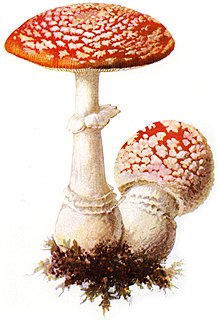
The genus Amanita contains about 600 species of agarics, including some of the most toxic known mushrooms found worldwide, as well as some well-regarded edible species. This genus is responsible for approximately 95% of the fatalities resulting from mushroom poisoning, with the death cap accounting for about 50% on its own. The most potent toxin present in these mushrooms is α-amanitin.

Amanita pantherina, also known as the panther cap and false blusher due to its similarity to the true blusher (Amanita rubescens), is a species of fungus found in Europe and Western Asia.

Muscimol is one of the principal psychoactive constituents of Amanita muscaria and related species of mushroom. Muscimol is a potent, selective agonist for the GABAA receptors and displays sedative-hypnotic, depressant and hallucinogenic psychoactivity. This colorless or white solid is classified as an isoxazole.

Amanita porphyria, also known as the grey veiled amanita, is a fairly common, inedible basidiomycete mushroom of the genus Amanita found in Europe and North America.

The Amanitaceae is a family of mushroom-forming fungi. The family, also commonly called the amanita family, is in order Agaricales, the gilled mushrooms. The family consists primarily of the large genus Amanita, but also includes the smaller genera Amarrendia, Catatrama, Limacella, Limacellopsis, Saproamanita, Torrendia and Zhuliangomyces. Both Amarrendia and Torrendia are considered to be synonymous with Amanita but appear quite different because they are secotioid.

The leopard darter is a small freshwater fish native to the United States, where it can be found only in the Little River drainage in Oklahoma and Arkansas. Its typical habitat is medium to large streams with rubble and boulder substrate. It feeds on small invertebrates on the riverbed and spawns mainly in March and April. It is threatened by impoundment, habitat loss and runoff from agricultural activities. It has never been a common species and has been listed as a threatened species in the United States since 1978, and the International Union for Conservation of Nature lists it as a "vulnerable species".
Amanita parvipantherina, also known as the Asian Small Panther Amanita, is a species of agaric restricted to Yunnan province in China. It is strongly associated with the Yunnan Pine Pinus yunnanensis. It fruits in July and August.

Amanita excelsa var. spissa is a variety of basidiomycete fungus of the genus Amanita. This large, grey to brown-capped fungus has a very variable appearance but is commonly encountered in coniferous and deciduous forests in Europe and North America. It is sometimes referred to by the common name grey spotted Amanita.

Cypraea pantherina, common name the panther cowry, is a species of large tropical sea snail, a cowry, a marine gastropod mollusk in the family Cypraeidae, the cowries.

The genus Oxythyrea consists of a number of chafer beetle species. Members are typically about 10–15 mm in size, and are usually black with white dots or lines on the thorax, elytra, and abdomen; each species has its own distinctive pattern. Oxythyrea are active during the day, and are often found on flowers, feeding.
Glossodoris pantherina is a species of sea slug, a dorid nudibranch, a shell-less marine gastropod mollusk in the family Chromodorididae.

Sybra is a genus of beetles in the family Cerambycidae, containing the following species:
Rathouisia pantherina is a species of carnivorous air-breathing land slug, terrestrial pulmonate gastropod mollusk in the family Rathouisiidae.
Gerontia is a genus of small air-breathing land snails, terrestrial gastropod mollusks in the family Charopidae.

Sybra umbratica is a species of beetle in the family Cerambycidae. It was described by Pascoe in 1865.

Sybra ordinata is a species of beetle in the family Cerambycidae. It was described by Bates in 1873.
Compsoctena is a genus of moths in the family Eriocottidae. It was erected by Philipp Christoph Zeller in 1852.

Jorunna pantherina is a species of sea slug, a dorid nudibranch, a shell-less marine gastropod mollusc in the family Discodorididae.

Parathelphusa pantherina, commonly known as the "panther crab", is a variety of freshwater crab from Indonesia from the family of the Gecarcinucidae. The scientific name of the species was published for the first time in 1902 by Schenkel. The species is categorized as Endangered by IUCN Red List due to damage to their habitat by mining of nickel from lake shores where they live, which negatively impacts their water quality.
Ameiva pantherina is a species of teiid lizard endemic to Venezuela.















